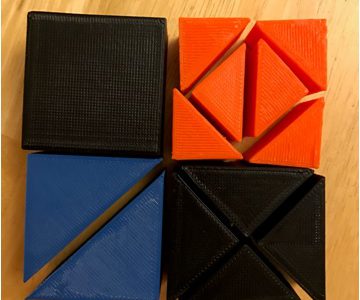
When designing this project, I was not sure what I would be designing or how I would be achieving it. I did know one thing; I wanted it to be about fractions. As a child, I had so much trouble with fractions. Looking back now, I think the issue was that I didn’t understand that a fraction is a part of a whole. I thought that fractions were just really weird looking numbers and they didn’t make sense in my head. As I started designing this, I played around with different shapes and design to try to show kids how fractions work and how they can understand the concept that a fraction is part of a whole.
In addition, I’m certain that this project will be a great mathematical learning tool for my students to develop an understanding in geometry, using the terms of spatial sense and geometrical reasoning, which means by turning, rotating, and reflecting the shapes that they will make. Also, this design will represent the concept of part- whole. Moreover, it gives a big picture of how fractions work by providing students with a visual which combined with a lesson can really make a difference on how the student will learn. This design will help the students develop their own way of computation of fraction by using strategies on noticing the numerator and denominator and using the based number sense, by focusing on the usage of contextual tasks approach. It will give them the visual that they need to understand fractions by exploring each operation with a variety of models which makes the students explain their solutions using designs and connect the design with the fraction.
The user of the manipulative is supported to learn from working with my design, by letting the user apply the fraction into the design while exploring and making a connection between each section of the design by using the terminology of 1/2, ¼, ¾ etc. Also it gives an opportunity for students to use the terms, bigger than, smaller than, and equal to. The user will be sectioning a shape into equal sized pieces called “partitioning.” In addition, the user will use the ten base concept counting by twos to measure the squares equally in each of the sides.
In terms of learning, a successful design is one that helps students learn without making them more confused and by assisting their thoughts. Its not to make them dependent on a manipulative, but more to guide them. This manipulative does not show my mathematical thinking but shows students that I also struggled with math. The reason I say this is that I tried to design something that will help those children, who like me, have no clue how to understand fraction. If the student has access to more that one of these manipulatives, it can also aid them on adding and subtracting fractions and by providing them with a visual. I wish, that when I was younger I had a manipulative to guide me and that might have changed my attitude towards fraction in general. Learning happens gradually and this design will help students achieve just that. It can be used for more simple fraction problems, but it can also be used for more complex ones.
If my design was to fail, I would go back and try to do it again. A good idea for designing is having your design tested. A way to do that is by getting students who are just learning fractions and present them with the manipulative and having another group of student learning fraction without using my manipulative. From there, we can compare test scores, and try to see how fast and how accurately they are learning with and with out the manipulative. If for whatever reason I find that the manipulative was not successful, I would go back to the drawing board and based on my observations, I would try to design it again. Another way to test it is by asking students who already know fractions and see what their intake would be to better the design.
In conclusion, I hope that this design can help students understand and master the art of fractions more adequately. Though I didn’t have an exact plan of how to design this and how to achieve learning, I think that by testing this design it can really revolutionize how students learn and most importantly understand fractions. Like I mentioned before, I would of loved for someone to have invented a design like this for what I was a child so that I can really understand the purpose of fractions, what a part of a whole means, how to add and subtract fractions, and how fractions can be found in everyday things and designs. This can also aid students to understand geometrical shapes, and how shapes make up one another.
